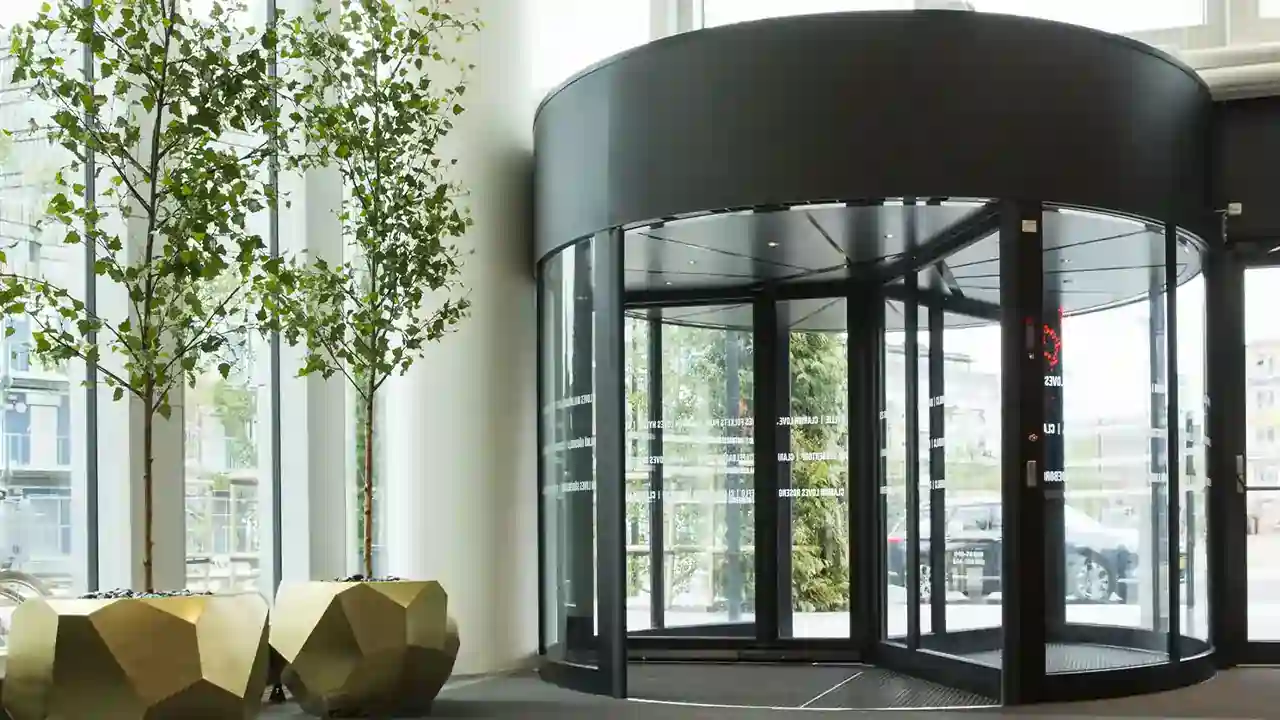16 Aug 2023

Revolving doors in UAE are a type of entrance system commonly found in buildings, hotels, and shopping malls. These doors allow people to enter and exit a building simultaneously while minimizing the loss of conditioned air and maintaining a comfortable indoor environment. Revolving doors have been used in UAE since the late 1800s and have become a popular choice due to their efficiency and aesthetic appeal. Revolving doors consist of interconnected panels rotating around a central axis, creating separate compartments for individuals to pass through. Revolving Doors in UAE reduce the amount of outside air that enters the building, helping to conserve energy and maintain a consistent temperature inside. Moreover, a revolving door in UAE also provide enhanced security by controlling the flow of people entering and exiting a building. Revolving Doors can accommodate many people at once, making them suitab le for high-traffic areas. Additionally, these doors are often equipped with safety features, such as sensors and emergency stop buttons, to ensure the well-being of users. Theophilus Van Kannel, an American inventor, made the first revolving door in 1888. His original design consisted of a series of four wings or panels that were connected to a central shaft. Early revolving doors were manually operated, meaning that people had to physically push the doors to make them rotate In the early 1900s, mechanics were added to automate revolving doors and power their movement. This innovation made it easier for people to enter and exit buildings, as they no longer had to push the doors themselves. Over the decades, revolving door designs evolved with new features to enhance safety, accessibility, and energy efficiency. For example, safety features such as sensors were introduced to detect obstructions and prevent the doors from closing on people. Today, revolving doors have become sophisticated entrance systems with advanced technologies, providing a seamless and efficient experience for users while meeting the requirements of modern buildings.History and Evolution:
Benefits and Advantages:
Manual Revolving Doors are operated by individuals pushing the door panels to rotate. Manual Revolving Doors require physical effort to move and are commonly found in smaller buildings or low-traffic areas. Manual revolving doors provide a basic and cost-effective solution for entryways.
Automatic Revolving Doors are powered by motors or automated systems, eliminating the need for manual pushing. Automatic Revolving Doors offer a convenient and effortless entry experience, particularly in high-traffic areas. Automatic revolving doors are equipped with sensors that detect the presence of people and adjust the rotation speed accordingly.
High-Speed Revolving Doors are designed to rotate at a faster speed, allowing for swift entry and exit. High-Speed Revolving Doors are commonly used in areas with heavy foot traffic, such as airports and train stations. High-speed revolving doors help maintain a comfortable indoor environment by minimizing the exchange of air between the inside and outside.
Low-Speed Revolving Doors rotate at a slower speed, providing a more leisurely entry experience. Low-Speed Revolving Doors are often used in buildings where a relaxed and elegant ambiance is desired, such as upscale hotels or luxury establishments.
These doors are specifically designed to enhance security measures. They feature advanced access control systems, such as biometric scanners or card readers, to ensure that only authorized individuals can enter.
Q1: Are revolving doors safe to use?
A: Yes, modern revolving doors are designed with various safety features such as sensors to detect obstructions, emergency collapsing mechanisms for quick evacuation, emergency stop buttons, low friction safety clutches, and clear safety signage.
Q2: Can people with disabilities use revolving doors?
A: Yes, newer models of revolving doors in the UAE are designed to meet accessibility standards, including those set by the Americans with Disabilities Act (ADA).
Q3: Do revolving doors consume a lot of energy?
A: No, revolving doors are actually energy-efficient. They create a barrier between the inside and outside of a building, preventing drafts and minimizing the loss of heated or cooled air.
Q4: Can revolving doors be used in high-traffic areas?
A: Yes, revolving doors are suitable for high-traffic areas. They are designed to handle a large volume of foot traffic, allowing people to enter and exit quickly and efficiently.
Q5: Can revolving doors be integrated with building access control systems?
A: Yes, modern revolving doors can be integrated with building access control systems. This allows for enhanced security measures, such as biometric scanners or card readers, to ensure that only authorized individuals can enter the building through the revolving door.
Revolving doors in UAE offer numerous advantages that make them a popular choice for buildings, hotels, and shopping malls. Revolving doors provide energy efficiency by preventing drafts and minimizing the loss of conditioned air, resulting in lower energy consumption and utility costs. They also offer access control, ensuring secure entry points that allow only one person at a time. Moreover, modern revolving doors in the UAE comply with accessibility standards, accommodating individuals with disabilities. Their elegant and upscale look enhances the aesthetics of buildings, creating a positive impression on visitors. For buyers and suppliers looking for reliable revolving door solutions in the UAE, TradersFind.com, a B2B website, serves as a valuable platform to connect and explore a wide range of options.
Discover a Wide Selection of Revolving Doors in Dubai | Abu Dhabi | Sharjah | Fujairah | Ras Al Khaimah |